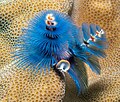Spirobranchus corniculatus
| Spirobranchus corniculatus | |
|---|---|

| |
| Surat Thani, Thailand, 2023 | |
| Scientific classification | |
| Domain: | Eukaryota |
| Kingdom: | Animalia |
| Phylum: | Annelida |
| Clade: | Pleistoannelida |
| Clade: | Sedentaria |
| Order: | Sabellida |
| Family: | Serpulidae |
| Genus: | Spirobranchus |
| Species: | S. corniculatus |
| Binomial name | |
| Spirobranchus corniculatus (Grube, 1862) | |
Spirobranchus corniculatus, commonly referred to as the Indo-Pacific Christmas tree worm, is a species of tube-building annelid fanworms in the family Serpulidae.[1][2] Belonging to the class Polychaeta, it is recognized for its bristle-like tentacles and the presence of a structure called radioles. It is widely encountered and recognized for its unique resemblance to a conifer and its diverse array of colors.[3] Initially presumed to be part of a species group including Spirobranchus cruciger and Spirobranchus gaymardi, it has been determined to be a singular, morphologically adaptable species inhabiting the Central Indo-Pacific region.[4]
Description
The Christmas tree worm is very vibrant in color and changes its color based on depth, camouflage, and a scare tactic.[5] It has bright spiral rings around its body segments or radioles, which can number more than 200 segments.[6] The body is abnormally large, ranging up to 45 mm (1.8 in) long and 0.5 mm (0.020 in) wide.[6]
Biology
The species predominantly engages in reproduction throughout its lifespan. Males use their coloration to attract females.[5] During mating, females emit a pheromone that signals males to release sperm. In turn, females release eggs; this action is called spawning.[7] Larvae are characterized by an elongated body.[8] The species also uses its color to make predators second guess their meal. The species primarily consumes suspended food particles, phytoplankton, and microalgae.[5]
Distribution and habitat
Spirobranchus corniculatus can be found in the tropical Indo-Pacific, specifically in corals such as Porites lobata, which are typically found in Hawaiian waters.[6] The Christmas tree worm inhabits depths of 3–30 m (9.8–98.4 ft)[8] and can also be found living on almost every species of coral.[5] It is mostly encountered in the eastern side of the globe, spanning Southeast Asia, the Indian Ocean, the central Pacific, and the northern region of Australia.[5]
Gallery
References
- ^ WoRMS. "Spirobranchus corniculatus (Grube, 1862)". World Register of Marine Species. Retrieved 2024-02-05.
- ^ "Indo-Pacific Christmas Tree Worm (Spirobranchus corniculatus)". iNaturalist. Retrieved 2024-03-05.
- ^ "Spirobranchus corniculatus, Marshall Islands". www.underwaterkwaj.com. Retrieved 2024-03-05.
- ^ Kupriyanova, Elena (2015-04-17). "Exploring the diversity of Christmas tree worms in Indo-Pacific coral reefs". The Australian Museum. Retrieved 2024-03-05.
- ^ a b c d e Perry, Orly; Sapir, Yuval; Perry, Gad; Hove, Harry Ten; Fine, Maoz (June 2018). "Substrate selection of Christmas tree worms (Spirobranchus spp.) in the Gulf of Eilat, Red Sea". Journal of the Marine Biological Association of the United Kingdom. 98 (4): 791–799. Bibcode:2018JMBUK..98..791P. doi:10.1017/S0025315416002022. ISSN 0025-3154.
- ^ a b c Reef and shore fauna of Hawaii. 2/3. Bishop Museum special publication. Honolulu, Hawai'i: Bishop Museum Press. 1987. ISBN 978-0-930897-11-6.
- ^ Idris, Izwandy; Mohd-Salleh, Nadia Azeera; Ahmad Fadzil, Nur Dalia Natasya (2022), "Host Preferences and Colouration of Christmas Tree Worms, Spirobranchus corniculatus (Grube, 1862) from Bidong Island, South China Sea", Bidong Island, Cham: Springer International Publishing, pp. 177–187, doi:10.1007/978-3-030-91924-5_15, ISBN 978-3-030-91923-8, retrieved 2024-03-04
- ^ a b "Spirobranchus corniculatus". www.sealifebase.ca. Retrieved 2024-03-04.
Further reading
- Willette, Demian A.; Iñiguez, Abril R.; Kupriyanova, Elena K.; Starger, Craig J.; Varman, Tristan; Toha, Abdul Hamid; Maralit, Benedict A.; Barber, Paul H. (September 2015). "Christmas tree worms of Indo-Pacific coral reefs: untangling the Spirobranchus corniculatus (Grube, 1862) complex". Coral Reefs. 34 (3): 899–904. Bibcode:2015CorRe..34..899W. doi:10.1007/s00338-015-1294-y. ISSN 0722-4028.


